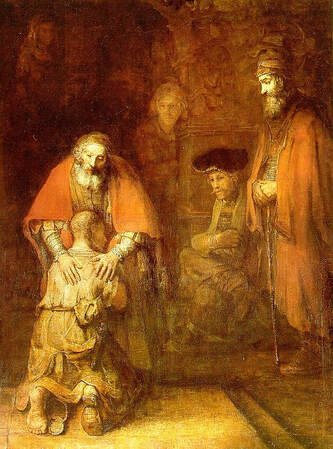|
A Message on Luke 15: The Parable of the Prodigal Son for the community at St. David of Wales, March 27, 2022 In the New International Version, and many others, this morning’s lesson from Luke is titled “The Story of the Lost Son.” In the Expanded Bible it’s “The Son Who Left Home.” The New Testament for Everyone labels it, “The Parable of the Prodigal: The Father and the Younger Son.” In the Contemporary English Version, the title reads “Two Sons.” And finally, the New Revised Standard Version follows suit with “The Parable of the Prodigal and His Brother.” No matter how we refer to it, this longest of Jesus’ parables which appears only in Luke’s gospel, has resonated deeply over the centuries, perhaps more than any other story Jesus told. And it still speaks to us in circles far beyond the church. Even as a secular child, I’d heard of the prodigal son—and even without knowing that the word prodigal (it’s something like recklessly wasteful), I knew the son was up to no good. I’m sure I encountered the parable as a Sunday School teacher and parishioner in my twenties, and thirties, but the first time I remember reading it, it came to me on a photocopied sheet of paper as the final assignment in the first creative writing class I took at community college as a mom of pre-teens back in the fall of 2000. The parable was titled simply, “A Story,” and after reading it aloud, my instructor had this to say:
“In my view, this famous story fails in almost every aspect of writing that we have been discussing this semester: lousy motivation and poor character development, way too much summary narration at crucial points, very little detail, and an unbelievable ending. We’ll discuss these issues and what it would take to make this story work in contemporary terms. Then, with these considerations in mind, you write your version.” This was my first invitation to enter the Bible imaginatively, to use the words of scripture not just as a study guide for living a moral life, but as a source of inspiration and creativity. I was given free reign to inhabit the parable, to invent new characters and new situations in order to understand and amplify Jesus’ message. Every family seems to have a prodigal someone. A cheater, addict, or opportunist who makes life altering mistakes and then runs away, or who runs away and then screws up. A person whose schemes leave them destitute, unemployed, and evicted, with no other choice than to return home. So, it wasn’t difficult for me to imagine a prodigal daughter. Though the mother forgave the daughter I’d written, the prodigal still had to live out the consequences of her actions, and trust had to be earned. The story revealed a belief I held but hadn’t quite grasped: That offering and accepting complete forgiveness was fine, for God. The rest of us had to deserve it. But there was no way to calculate deservedness. The deep belief that forgiveness demands an accounting is a character trait consistent with the older brother in Jesus’ parable—a character I managed to leave out of my story completely. Six months later, in June 2001, I had the opportunity to preach this parable on Father’s Day. In my sermon preparation, I came upon Dutch priest Henri Nouwen’s 1992 book, The Return of the Prodigal Son, an account of how Rembrandt’s painting of the prodigal son’s return shaped his life. Nouwen, who left his home in the Netherlands for life in the U.S. wrote about his initial identification with the prodigal, but he came to realize that though he was geographically distant, he was not the greedy and callous younger son who said essentially, “You’re dead to me, Dad. Hand over the cash.” As a priest and college professor bound to formal institutions, Nouwen came to see that as a church man, he was much more like the older son who refuses to join the celebration, standing by in judgement as God welcomed others home. As I read about his identification with the older brother, I saw myself clearly in that role as well. The literal oldest child, the rule follower who stays behind to keep things running, the one who must be perfect because everyone else is unreliable. Like the prodigal who refers to his own brother as “that son of yours,” I identified with the wary, weary, resentful son, afraid of being sucked back in by the prodigal’s false promises. The unforgiving son who sees the father as unappreciative and unfair, and weak and foolish for being manipulated. Fast forward twenty years and I’m gifted with the opportunity to immerse myself in this passage, Nouwen’s book, and Rembrandt’s painting once again. This time I approach with return as a 60-year-old who has launched children into the world, uprooted an entire life, rebuilt a new one in a new state, lost more dear ones than I want to count, and reconciled relationships I never thought possible. This time around, it is the father who now shimmers before me, standing in a pool of light as he does in Rembrandt’s painting. As a young man, Rembrandt painted himself as “The Prodigal Son in the Tavern,” and “The Prodigal Son in the Brothel,” seemingly celebrating the carefree carousing life. “The Return of the Prodigal Son,” is one of Rembrandt’s final paintings, completed shortly before his death in 1669. In the work, Rembrandt, who outlived all five of his children, and both his wives, portrays himself as the father, frail and nearly blind, a man who has known great suffering, and extends a compassionate loving, embrace. Nouwen writes of a spiritual journey that led him to examine his life through the lens of each character in the parable, and he calls us to do the same. First like the younger son, we’re challenged to recognize our need for repentance, for confessing, accepting, and basking in the joy of being welcomed by God after wandering and failure. Then we are called to set aside any bitterness and resentment that separates us, as it does the older brother, from one another and from God. We’re called to accept and embrace our belonging. And finally, once we are secure in the knowledge of God’s love for us, we are called to become like the father. We are called to create space in our lives and hearts where others may come to experience God's forgiveness and reconciliation. As I read Nouwen’s book a second time, part of me thought, “What a beautiful and glorious insight,” while another part of me thought, “Act like God? That’s never going to happen.” Our journey with Jesus in the Lenten season brings into sharp distinction the clash between his message, and that of the religious and political authorities of his time. And it highlights that we still live in the tension between our hope for the wide-open all-encompassing just-and-generous love of God to govern all of life, and the reality of man-made systems that dehumanize and oppress many for the benefit of the few. Living in that tension, I’m thankful for the artistic expression scripture inspires, like Rembrandt’s Return of the Prodigal Son. In it I see two unnamed women in the shadows, and wonder who they are—wife, mother, daughter—and how they’ve influenced the scene. I see the older son standing inside the house. And though he is not inside the father’s embrace, I see light on his face and wistful longing in his eyes, as if soon he will step into his father’s arms. I see the exhausted and contrite younger son reuniting with his family, moved beyond words with gratitude, tears flowing. And I see in the father a love generous enough to have let go and allow both sons to live their choices. I see the grief that letting go exacts, and the hard-won equanimity and wisdom of accepting what cannot be changed. I see in the father a gaze softened by circumstance, the bone-deep relief and joy in the reunion never thought possible. I feel the heart-deep compassion for all that has been suffered, and the assurance love that endures all things. And looking closely at the father’s embrace, I see the hands Rembrandt has rendered. One aged, wide, firm. One soft, smooth, tender. This father is more than father. This father is not bound to time. Though wounded like Jesus, this father is wholly human while radiating divinity. In these past two years, the pandemic has taken the lives of those we love. It has kept us apart. Care for each other’s safety has unintentionally isolated us. Pastoral transition has shifted the stability we crave in a worshipping community. And now war threatens our peace of mind, feeling helpless feeds our anxiety. Yet in the midst of all this, we found new ways to gather. We found new ways to honor the departed and celebrate the milestones of living. We found new ways to worship and pray for and with one another. And we’re finding ways to support those who feed the hungry and house refugees. Because of our history, together and apart, because of our circumstances and choices now and long ago, because of all that we have loved, and all that we have suffered, and all that we have believed and all that we have doubted, because of our resilience, and our faith, however fragile, I see each one of us becoming that father-mother-creator-comforter. Like the father in Rembrandt’s painting, we gleam with God’s light, and hold out our arms to another hurting human desperate for belonging. We offer love and forgiveness, without condition. We speak forgiveness with a touch, with a tear, with a word if it comes. May you and I embody that father, if only for a moment. And may that moment carry us as far and long, delivering us, finally to God’s eternal embrace.
0 Comments
Your comment will be posted after it is approved.
Leave a Reply. |
I began blogging about "This or Something Better" in 2011 when my husband and I were discerning what came next in our lives, which turned out to be relocating to Puget Sound from our Native California. My older posts can be found here.
Categories
All
Archives
September 2023
Newsletters |

